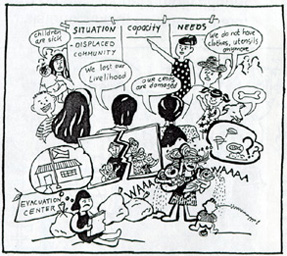|
Urban Disaster Mitigation Project in Thailand
Numerous hazards affect Thailand, including floods, typhoons, droughts, landslides, forest fires and man-made hazards such as urban fires and hazardous chemical spills. An analysis of disaster impact on Thailand finds that the greatest loss of life and property is caused by floods. Although there have been many years of work and extensive measures already taken against water-related disasters, Thailand continues to be extremely vulnerable to flooding because of rapid urbanization, population growth, deforestation and climate change.
The decentralization process in Thailand will place increased responsibility on local governments to plan and manage cities and towns. Decentralization in an urbanizing Thailand provides a good
environment and policy framework to start the Thailand Urban Disaster Mitigation Project (TUDMP), which aims to integrate disaster mitigation into urban development planning
processes.
An AUDMP team carried out preliminary research for the Thailand project, which led to the development of a concept paper (available upon request). Following consultation with key departments and divisions in government ministries, including the Department of Local Administration, the Civil
Defense Division and the National Economic and Social Development Board, as well as academic institutions, non-governmental organizations and donors, ADPC has identified Hat Yai Municipality in southern Thailand as a demonstration site for TUDMP.
The national demonstration site will provide a working example of urban disaster mitigation which involves assessments of hazard, vulnerability and risk. From these assessments, mitigation strategies will be identified, prioritized and implemented. Disaster mitigation training, awareness raising, information dissemination and community-based approaches to disaster mitigation will be executed as part of the disaster mitigation process, first at the demonstration site, but with the aim to replicate and institutionalize disaster mitigation throughout Thailand. The design of the TUDMP commenced in April 2001.
National Consultation Workshop on Extreme Climate Events and Their Impacts on Society and the Environment in the Philippines
In collaboration with the Office of Foreign Disaster Assistance (OFDA) and the National
Oceanic and Atmospheric Administration (NOAA) of The United States, ADPC has undertaken a project on understanding extreme climate events in Indonesia, the Philippines and Vietnam. The project is implemented in the Philippines by the National Disaster Coordinating Council (NDCC) of the Office of Civil Defense.
A 31 January 2000 Scoping Workshop kicked off the project, followed by a quick assessment study on the impacts of and responses to extreme climate events in the climate prediction, food and agriculture, water resources, health, environment, and disaster management sectors. The assessment was carried out by technical working groups led by the Philippine Atmospheric, Geophysical and Astronomical Services Administration (PAGASA), the Department of Agriculture, National Water Resources Board, Department of Health, Department of Environment and Natural Resources, and NDCC.
The findings of the study were presented to a National Consultation Workshop organized by ADPC in collaboration with PAGASA from 18-19 April 2001 in Manila. The workshop will
assess opportunities for and constraints to the translation of global El Ni–o Southern Oscillation (ENSO) parameters into local weather variables in the Philippines, present potential applications of ENSO forecast information to manage future El Ni–o and La Ni–a events, and evolve an organizational framework for institutionalizing the climate forecast and application system in the Philippines.
|
Program for Enhancement of Emergency Response (PEER)
Workshop on Hospital Preparedness for Emergency (HOPE)
A HOPE workshop was held from 21-23 February 2001. The nine participants included three from each of the countries participating in PEER: Indonesia, Nepal and the Philippines. The main objective of the workshop was to discuss and design an outline for developing a training package using baseline data findings from the three countries. The workshop ended with the consolidation of an expert group to develop the training package. A decision was also made to meet every three months to successfully complete the design, development and implementation of the HOPE pilot course.
The rationale behind designing a new course curriculum is to add a module on preparedness and readiness to cope with emergency situations to the present format of both MFR (Medical First
Response) and CSSR (Collapsed Structure Search and Rescue), which focus on pre-hospital care of victims.
Regional Course on Collapsed Structure Search and Rescue (CSSR)
Through PEER, and in collaboration with OFDA (Office of Foreign Disaster Assistance) and MDFRD (Miami-Dade Fire Rescue Department), ADPC conducted a Collapsed Structure Search and Rescue (CSSR) pilot training course and a CSSR review workshop from 18-31 March 2001 in Chiang Mai, Thailand. The CSSR course lasted for eight days, followed by a two-day review of the course content. The purpose of the course was to provide people working on collapsed structure rescue tasks with necessary knowledge and skills to search for, stabilize and extricate victims trapped in collapsed structures, using the safest state-of-the-art procedures.
Changing Concepts of Disaster Management

Before
Damage and needs assessment are rapidly done by external experts | 
Now
Damage, needs and capacity assessments are done with people's participation, considering gender, culture and age |
|



![]() To get announcements whenever this page is updated, please subscribe to adpc-announce-subscribe@egroups.com
by sending a blank email.
To get announcements whenever this page is updated, please subscribe to adpc-announce-subscribe@egroups.com
by sending a blank email.